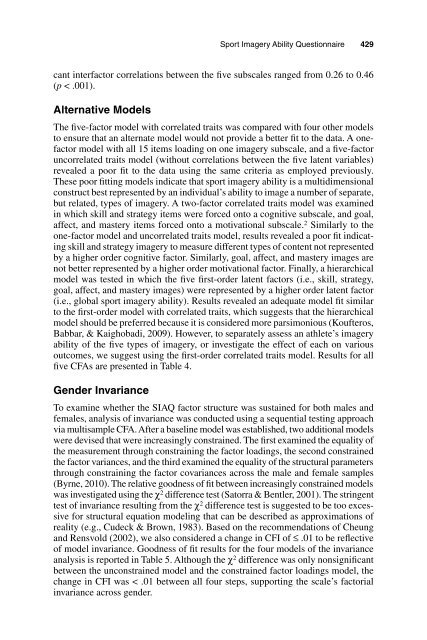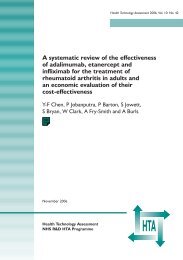Measuring Athlete Imagery Ability: The Sport ... - ResearchGate
Measuring Athlete Imagery Ability: The Sport ... - ResearchGate
Measuring Athlete Imagery Ability: The Sport ... - ResearchGate
You also want an ePaper? Increase the reach of your titles
YUMPU automatically turns print PDFs into web optimized ePapers that Google loves.
<strong>Sport</strong> <strong>Imagery</strong> <strong>Ability</strong> Questionnaire 429<br />
cant interfactor correlations between the five subscales ranged from 0.26 to 0.46<br />
(p < .001).<br />
Alternative Models<br />
<strong>The</strong> five-factor model with correlated traits was compared with four other models<br />
to ensure that an alternate model would not provide a better fit to the data. A onefactor<br />
model with all 15 items loading on one imagery subscale, and a five-factor<br />
uncorrelated traits model (without correlations between the five latent variables)<br />
revealed a poor fit to the data using the same criteria as employed previously.<br />
<strong>The</strong>se poor fitting models indicate that sport imagery ability is a multidimensional<br />
construct best represented by an individual’s ability to image a number of separate,<br />
but related, types of imagery. A two-factor correlated traits model was examined<br />
in which skill and strategy items were forced onto a cognitive subscale, and goal,<br />
affect, and mastery items forced onto a motivational subscale. 2 Similarly to the<br />
one-factor model and uncorrelated traits model, results revealed a poor fit indicating<br />
skill and strategy imagery to measure different types of content not represented<br />
by a higher order cognitive factor. Similarly, goal, affect, and mastery images are<br />
not better represented by a higher order motivational factor. Finally, a hierarchical<br />
model was tested in which the five first-order latent factors (i.e., skill, strategy,<br />
goal, affect, and mastery images) were represented by a higher order latent factor<br />
(i.e., global sport imagery ability). Results revealed an adequate model fit similar<br />
to the first-order model with correlated traits, which suggests that the hierarchical<br />
model should be preferred because it is considered more parsimonious (Koufteros,<br />
Babbar, & Kaighobadi, 2009). However, to separately assess an athlete’s imagery<br />
ability of the five types of imagery, or investigate the effect of each on various<br />
outcomes, we suggest using the first-order correlated traits model. Results for all<br />
five CFAs are presented in Table 4.<br />
Gender Invariance<br />
To examine whether the SIAQ factor structure was sustained for both males and<br />
females, analysis of invariance was conducted using a sequential testing approach<br />
via multisample CFA. After a baseline model was established, two additional models<br />
were devised that were increasingly constrained. <strong>The</strong> first examined the equality of<br />
the measurement through constraining the factor loadings, the second constrained<br />
the factor variances, and the third examined the equality of the structural parameters<br />
through constraining the factor covariances across the male and female samples<br />
(Byrne, 2010). <strong>The</strong> relative goodness of fit between increasingly constrained models<br />
was investigated using the χ 2 difference test (Satorra & Bentler, 2001). <strong>The</strong> stringent<br />
test of invariance resulting from the χ 2 difference test is suggested to be too excessive<br />
for structural equation modeling that can be described as approximations of<br />
reality (e.g., Cudeck & Brown, 1983). Based on the recommendations of Cheung<br />
and Rensvold (2002), we also considered a change in CFI of ≤ .01 to be reflective<br />
of model invariance. Goodness of fit results for the four models of the invariance<br />
analysis is reported in Table 5. Although the χ 2 difference was only nonsignificant<br />
between the unconstrained model and the constrained factor loadings model, the<br />
change in CFI was < .01 between all four steps, supporting the scale’s factorial<br />
invariance across gender.
















